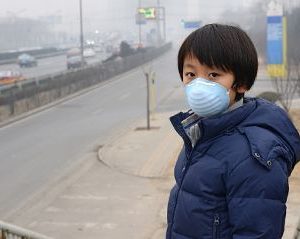- Navigating Your Midlife Crisis: Embracing New Possibilities
- City Raccoons Showing Signs of Domestication
- Mapping the Exposome: Science Broadens Focus to Environmental Disease Triggers
- One Week Less on Social Media Linked to Better Mental Health
- Your Brain Changes in Stages as You Age, Study Finds
- Some Suicide Victims Show No Typical Warning Signs, Study Finds
- ByHeart Formula Faces Lawsuits After Babies Sickened With Botulism
- Switch to Vegan Diet Could Cut Your Greenhouse Gas Emissions in Half
- Regular Bedtime Does Wonders for Blood Pressure
- Dining Alone Could Mean Worse Nutrition for Seniors
Breathing Dirty Air Could Raise a Child’s Risk for Adult Mental Illness

Kids exposed to air pollution may be at risk for mental illness in early adulthood, a new study suggests.
Researchers found that young adults in Britain who were exposed to higher levels of traffic-related air pollutants during their childhood and teen years were prone to develop symptoms of mental illness later. Nitrogen oxides were a particular problem, the study authors reported.
“Our findings suggest that early life air pollution exposure is a non-specific risk factor for mental illness writ large,” said lead researcher Aaron Reuben, a doctoral student in clinical psychology at Duke University in Durham, N.C.
Reuben cautioned that this study does not prove air pollution causes mental illness, only that there seems to be a link.
“The effects identified in the study were small, but because many people around the world are exposed to high levels of air pollution, the findings have important implications for population-level public health,” Reuben said.
Higher rates of mental illness symptoms seen at age 18 applied to all types of psychiatric disorders, he noted.
Although the study was done in Britain, Reuben said that “air pollution levels in the U.S. are similar enough that we feel our findings generalize to this and other high-income developed countries.”
For the study, Reuben’s team collected data on over 2,000 twins born in England and Wales in 1994 and 1995. The participants were followed to young adulthood.
The researchers measured exposure to air pollutants, such as nitrogen oxides (NOx, a gaseous pollutant), and fine particulate matter (PM2.5, tiny particles suspended in the air).
Nearly 22% of participants were exposed to NOx levels that exceeded World Health Organization guidelines, and 84% to PM2.5 levels above the guidelines.
The investigators assessed participants’ mental health at age 18. They looked for symptoms tied with dependence on alcohol, cannabis or tobacco; conduct disorder and attention-deficit/hyperactivity disorder; major depression, generalized anxiety disorder, post-traumatic stress disorder, and eating disorder; and thought disorder symptoms related to psychosis.
These were used to calculate what researchers dubbed the psychopathology factor, or “p-factor.” The higher the p-factor, the worse mental health was.
The effects of air pollution on mental health were seen across all types of psychological problems, the study team said.
The researchers also looked at characteristics of children’s neighborhoods to account for conditions associated with higher levels of air pollution and greater risk of mental illness, including poverty, danger and social disconnection. They said these factors did not change the link between air pollution and mental health.
Brittany LeMonda, a senior neuropsychologist at Lenox Hill Hospital in New York City, reviewed the findings. She said, “This research is important as it may help identify those at risk for psychiatric illness in certain neighborhoods with greater air pollution.”
Reuben said scientists already know from research with animal models and autopsy studies in humans that air pollution contains a complex mixture of toxic substances that may impair the brain.
He said the exact mechanisms are still unclear, but systemic inflammation is strongly suggested. In other words, air pollutants that penetrate the lungs’ deepest tissue and may circulate in the bloodstream trigger an immune response that may harm brain health, he said.
“In some cases, it is believed, air pollutants may reach the brain directly, through the nose, where they may also cause an immune response that may harm brain tissue,” Reuben said. “Consequences include leaky blood-brain barriers, neuronal death, disruptions to neuron proliferation and signaling, and a wide variety of other problems.”
Some youngsters are probably at greater risk, he said.
“Certainly those with higher exposures are the most concern, which would include children exposed at home or school due to emissions from vehicles or facilities such as power plants and waste incinerators,” Reuben said.
Families who live along busy roads or highways are likely to have the highest exposures, he said.
“Aside from that, we can only speculate on factors that may make children more vulnerable to the effects of pollution, either because they are genetically predisposed to mental illness or because they have other stressors, such as chaotic home environments, that put them at risk,” Reuben added.
Kai Chen, an assistant professor of epidemiology at the Yale School of Public Health in New Haven, Conn., also reviewed the findings.
“We need to better understand the mixture nature of air pollution, including both gases, pollutants such as NOx, and particles such as PM2.5,” Chen said. “Both pollutants share similar sources, such as traffic emissions. Thus, policies targeting combustion sources could reduce multiple air pollutants, which will improve public health.”
The findings were published online April 28 in JAMA Network Open.
More information
For more about air pollution and mental health, visit the American Psychological Association.
SOURCES: Aaron Reuben, MEM, doctoral student, clinical psychology, Duke University, Durham, N.C.; Kai Chen, PhD, assistant professor, epidemiology (environmental health), Yale School of Public Health, New Haven, Conn.; Brittany LeMonda, PhD, senior neuropsychologist, Lenox Hill Hospital, New York City; JAMA Network Open, April 28, 2021, online
Source: HealthDay
Copyright © 2025 HealthDay. All rights reserved.










